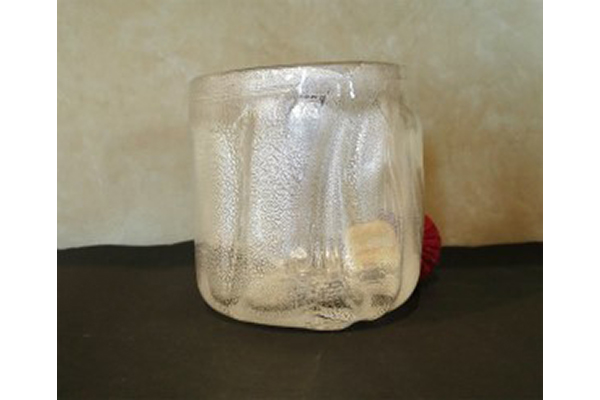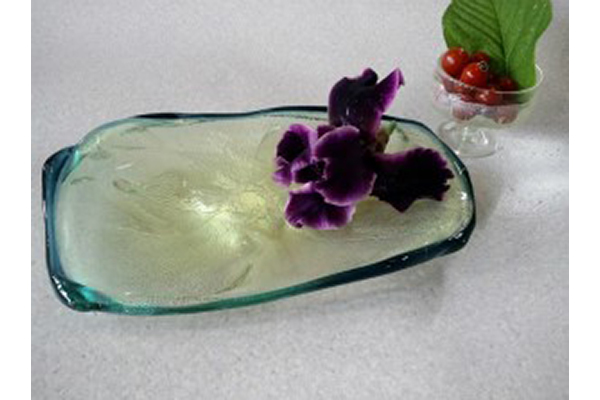EPISODE OF FAUNDATION / FOUNDER'S THOUGHT
It was one of the greatest wishes of the late Akira Ichiya to establish a studio in his hometown of Obanazawa, Yamagata Prefecture, and continue his work in his late years there and teach his glass-working technique.
Many considered the idea of setting up a studio by Lake Tokurako as reckless since the area was still a wilderness hinterland.
He undoubtedly was also motivated by the fact that the art of glass working was gradually beginning to be acknowledged in the Tohoku region at the time and wanted it to take root in Yamagata Prefecture.
CRAFTMAN'S THOUGHT, COMMITMENT / RELATIONSHIP WITH THE COMMUNITY
I believe ginsai glass (glass with silver overglaze) brings out the beauty of what's served with it (be it food, beverages or flowers), and vice versa.
Neither opaque nor clear, the translucency of the silver makes the food and beverages appear crisp and tasty, and the colors of the food and beverages enhance the luster of the silver.
I endeavor to express the silver snow that falls on Ginza Onsen by gentle and tender shapes and expressions that cannot be achieved through the use of molds.
A piece that embodies the late Akira Ichiya's hallmark technique. In this work, gold-color yokisai appears—a kiln effect achieved by firing glass and silver foil in the kiln. In his late years, Ichiya worked on religious motifs, and this is a piece from the "Okina" series, a collection of mystical and stately pieces of glasswork adorned in yokisai, which is a deeper color than that of gold foil.
A lowball glass from the ginsai glass "Shirogane" series, made by layering a silver foil between pieces of glass. The wavy glass surface obscures the refraction of light, the color of the beverage and its contrast with the silver foil, making the beverage look refreshingly cool.
A sake cup from the ginsai glass ""Shirogane"" series made by layering silver foil between pieces of glass.
The wavy glass surface obscures the refraction of light, the color of the beverage and its contrast with the silver foil, making the beverage look refreshingly cool.
I make them in various sizes based on my intuition rather than determining a certain size or thickness.
A cocktail glass from the ginsai glass "Shirogane" series made by layering silver foil between pieces of glass.The wavy glass surface obscures the refraction of light, the colors of the fruits and their contrast with the silver foil, making the fruits look refreshingly cool. Makes cherries, Yamagata Prefecture's specialty, appetizing and beautiful when served.
An irregular-shaped plate from the ginsai glass "Shirogane" series, made by layering silver foil between pieces of glass. The wavy glass surface induces the refraction of light, which together with the contrast between the food color and the silver foil makes food look refreshingly cool. No. 40-27 features a green lip wrapped around the edge of the rim. Within this Shirogane series, the nuance created by the twisted underglazed silver and kiln effect are more manifest in plates than in glasses.
A shallow bowl from the ginsai glass ""Saryu"" series, made by layering silver foil between pieces of glass.In this series, the silver foil is placed nearer to the surface, and oxidization is reduced with the help of glass sand. This allows the surface color to turn gold after being fired in the kiln, resulting in a color similar to that of yokisai. No. 35-13 features a cobalt lip wrapped around the rim. The expressions created by the twisted underglazed silver and the transparent glow of the clear glass on the inside create an eye-pleasing texture.

-
Brand name
Ginsai Glass [Hotaruyuki]
-
Product name
Ginsai glass [Hotaruyuki] Flower vase
-
Generic name
Flower vase
-
Materials
Glass, Silver foil
-
Person in Charge
Naohito Ito
-
Production area
Obanazawa Yamagata Japan
-
Size
17cm x 21cm
-
Weight
-
Domestic retail price
JPY80,000 (excluding tax)
A flower vase from the ginsai glass "Hotaruyuki" series, made by layering silver foil between pieces of glass.By placing a coal-black glass piece under the silver foil, the scattered silver spots on the underglaze silvers look as if they are floating. The subtle kiln effect rising up from the base adds a mystical atmosphere to this piece. The work expresses the snow, dimly lit like fireflies, falling on the Tohoku region, Obanazawa, and Ginza Onsen.
A large bowl from the ginsai glass "Kofu" series, made by layering silver foil between pieces of glass. The refraction of light created by the wavy surface and the shadow of the plate on the cloth underneath create an otherworldly atmosphere to this artwork. Pale green glass is used instead of clear glass. The piece is an expression of Lake Tokurako in Obanazawa, where the studio is located, and the wind blowing in the area.
A flower vase from the ginsai glass "Shirogane" series, made by layering silver foil between pieces of glass. The wavy glass surface obscures the refraction of light, the colors of the stem and flower petals, and their contrast with the underglazed silver, making the flowers look refreshingly cool.
A piece that embodies the late Akira Ichiya's hallmark technique. An object made up of three parts, created by layering silver foil between pieces of glass (ginsai). In his late years, Ichiya worked on religious motifs. This is a tall artistic glasswork in a black shade with an air of stateliness and a distinctively Japanese atmosphere. The title, kaiko (encounter), is believed to be themed on an encounter with the gods, or reincarnation.
A flower vase from the ginsai glass "Ayanagi" series, made by blowing a glass mass with silver foil. An advanced version of the technique used in the Saryu series is employed here, in which numerous pigments are added before applying underglazed silver. Silver foil is placed nearer to the surface and oxidization is reduced with the help of glass sand. The glass turns to a gold color, similar to yokisai, after it is fired in the kiln. The pigment flow adds to the dimension of the underglazed silver.。
A tea container from the ginsai glass "Ayanagi" series, made by blowing a glass mass with silver foil. An advanced version of the technique used in the Saryu series is employed here, in which numerous pigments are added before applying underglazed silver. Silver foil is placed nearer to the surface and oxidization is reduced with the help of glass sand. The glass turns to a gold color, similar to yokisai, after it is fired in the kiln. The pigment flow adds to the dimension of the underglazed silver. The lid is also made of glass.
A pitcher from the ginsai glass "Shirogane" series made by layering silver foil between pieces of glass. The wavy glass surface obscures the refraction of light, the color of water and its contrast with the silver foil, making the beverage look refreshingly cool. When the lid is opened, the pot admits the light and bestows a different expression.
A beer glass from the ginsai glass "Yuragino" series, made by blowing a glass mass with silver foil. With a surface that is neither an opaque or clear surface created by other materials nor pigmented, this silver smoked glass does not disturb the color of the beverage therein, but makes it look appetizing and beautiful. The contrast between the silver smoked glass will make beverages look more refreshingly cool. The wavy glass will bestow Yuragino glassware with a delicate and flickering expression.

-
Brand name
Ginsai glass [Yuragino]
-
Product name
951-4 Ginsal glass [Yuragino] Flower vase
-
Generic name
Flower vase
-
Materials
Glass, Silver foil
-
Person in Charge
Naohito Ito
-
Production area
Obanazawa Yamagata Japan
-
Size
-
Weight
-
Domestic retail price
JPY5,000 - 15,000 (excluding tax)
A flower vase from the ginsai glass "Yuragino" series, made by blowing a glass mass with silver foil. With a surface that is neither an opaque or clear surface created by other materials nor pigmented, this silver smoked glass does not disturb the color of the beverage therin, but makes it look appetizing and beautiful. The wavy glass surface bestows Yuragino glassware with delicate and flickering impression so you can enjoy the expressions of the flower stems.

















